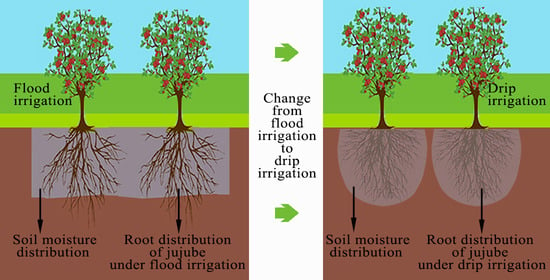Adapting Root Distribution and Improving Water Use Efficiency via Drip Irrigation in a Jujube (Zizyphus jujube Mill.) Orchard after Long-Term Flood Irrigation
Abstract
:1. Introduction
2. Materials and Methods
2.1. Experimental Site
2.2. Experimental Design and Field Management
2.3. Measurements
2.3.1. Soil Moisture
2.3.2. Root Sampling
2.4. Root Simulation
2.5. Data Analysis
3. Results
3.1. Soil Water Distribution
3.2. Soil Water Storage
3.3. Root Length Density
3.3.1. Vertical Distribution of RLD
3.3.2. Horizontal Distribution of RLD
3.3.3. RLD of Different Diameter Roots
3.4. Model Application
3.5. Yield and WUE
4. Discussion
5. Conclusions
Author Contributions
Funding
Institutional Review Board Statement
Informed Consent Statement
Data Availability Statement
Conflicts of Interest
References
- Sheng, J.; Shen, L. Chinese Jujube (Ziziphus jujuba Mill.) and Indian Jujube (Ziziphus mauritiana Lam.); Postharvest Biology and Technology of Tropical and Subtropical Fruits; Woodhead Publishing: Cambridge, MA, USA, 2011; pp. 299–326. [Google Scholar] [CrossRef]
- Cui, N.B.; Du, T.S.; Li, F.S.; Tong, L.; Kang, S.Z.; Wang, M.X.; Liu, X.Z.; Li, Z.J. Response of vegetative growth and fruit development to regulated deficit irrigation at different growth stages of pear-jujube tree. Agric. Water Manag. 2009, 96, 1237–1246. [Google Scholar] [CrossRef]
- Bai, T.C.; Wang, T.; Zhang, N.N.; Chen, Y.Q.; Mercatoris, B. Growth simulation and yield prediction for perennial jujube fruit tree by integrating age into the WOFOST model. J. Integr. Agric. 2020, 19, 721–734. [Google Scholar] [CrossRef]
- Wang, H.; Li, J.; Cheng, M.; Zhang, F.; Wang, X.; Fan, J.; Wu, L.; Fang, D.; Zou, H.; Xiang, Y. Optimal drip fertigation management improves yield, quality, water and nitrogen use efficiency of greenhouse cucumber. Sci. Hortic. 2019, 243, 357–366. [Google Scholar] [CrossRef]
- Wang, Z.; Bian, Q.; Zhang, J.; Zhou, B. Optimized water and fertilizer management of mature jujube in xinjiang arid area using drip irrigation. Water 2018, 10, 1467. [Google Scholar] [CrossRef] [Green Version]
- Zhang, A.; Zheng, C.; Li, K.; Dang, H.; Cao, C.; Rahma, A.E.; Zhang, J.; Feng, D. Responses of soil water-salt variation and cotton growth to drip irrigation with saline water in the low plain near the Bohai sea. Irrig. Drain 2020, 69, 448–459. [Google Scholar] [CrossRef]
- Yang, D.; Li, S.; Kang, S.; Du, T.; Guo, P.; Mao, X.; Tong, L.; Hao, X.; Ding, R.; Niu, J. Effect of drip irrigation on wheat evapotranspiration, soil evaporation and transpiration in Northwest China. Agric. Water Manag. 2020, 232, 106001. [Google Scholar] [CrossRef]
- Moroke, T.S.; Schwartz, R.C.; Brown, K.W.; Juo, A.S.R. Soil water depletion and root distribution of three dryland crops. Soil Sci. Soc. Am. J. 2005, 69, 197–205. [Google Scholar] [CrossRef] [Green Version]
- Liu, R.X.; Zhou, Z.G.; Guo, W.Q.; Chen, B.L.; Osterbuis, D.M. Effects of N fertilization on root development and activity of water-stressed cotton (Gossypium hirsutum L.) plants. Agric. Water Manag. 2008, 95, 1261–1270. [Google Scholar] [CrossRef]
- Chen, Y.L.; Palta, J.; Clements, J.; Buirchell, B.; Siddique, K.H.M.; Rengel, Z. Root architecture alteration of narrow-leafed lupin and wheat in response to soil compaction. Field Crops Res. 2014, 165, 61–70. [Google Scholar] [CrossRef] [Green Version]
- Li, P.F.; Cao, X.Q.; Tan, H.; Wang, J.H.; Ren, S.M.; Yang, P.L. Studies on water uptake and heat status of cherry root under water-saving measures. Agric. Water Manag. 2020, 242, 106359. [Google Scholar] [CrossRef]
- Ruiz-Sanchez, M.C.; Plana, V.; Ortuno, M.F.; Tapia, L.M.; Abrisqueta, J.M. Spatial root distribution of apricot trees in different soil tillage practices. Plant Soil. 2005, 272, 211–221. [Google Scholar] [CrossRef]
- Forde, B.; Lorenzo, H. The nutritional control of root development. Plant Soil. 2001, 232, 51–68. [Google Scholar] [CrossRef]
- Fernandes, R.D.M.; Egea, G.; Hernandez-Santana, V.; Diaz-Espejo, A.; Fernandez, J.E.; Perez-Martin, A.; Cuevas, M.V. Response of vegetative and fruit growth to the soil volume wetted by irrigation in a super-high-density olive orchard. Agric. Water Manag. 2021, 258, 107197. [Google Scholar] [CrossRef]
- Cao, X.C.; Wu, L.L.; Lu, R.H.; Zhu, L.F.; Zhang, J.H.; Jin, Q.Y. Irrigation and fertilization management to optimize rice yield, water productivity and nitrogen recovery efficiency. Irrig. Sci. 2021, 39, 235–249. [Google Scholar] [CrossRef]
- Watson, W.T.; Appel, D.N.; Arnold, M.A.; Kenerley, C.M. Spatial distribution of Malus root systems in irrigated, trellised orchards. J. Hortic. Sci. Biotechnol. 2006, 81, 745–753. [Google Scholar] [CrossRef]
- Kadyampakeni, D.M.; Morgan, K.T.; Schumann, A.W.; Nkedi-Kizza, P. Effect of irrigation pattern and timing on root density of young citrus trees infected with Huanglongbing disease. Horttechnology 2014, 24, 209–221. [Google Scholar] [CrossRef]
- Chilundo, M.; Joel, A.; Wesstrom, I.; Brito, R.; Messing, I. Response of maize root growth to irrigation and nitrogen management strategies in semi-arid loamy sandy soil. Field Crops Res. 2017, 200, 143–162. [Google Scholar] [CrossRef]
- Li, X.; Tian, D.; Guo, K.; Xu, B.; Zhao, S. Influence of mulch drip irrigation on wheat root distribution characteristics. Irrig. Mach. Eng. 2016, 34, 545–552. [Google Scholar] [CrossRef]
- Ma, L.H.; Liu, X.L.; Wang, Y.K.; Wu, P.T. Effects of drip irrigation on deep root distribution, rooting depth, and soil water profile of jujube in a semiarid region. Plant Soil. 2013, 373, 995–1006. [Google Scholar] [CrossRef]
- Salgado, E.; Cautin, R. Avocado root distribution in fine and coarse-textured soils under drip and microsprinkler irrigation. Agric. Water Manag. 2008, 95, 817–824. [Google Scholar] [CrossRef]
- Ma, L.H.; Wu, P.T.; Wang, X. Root distribution chrono sequence of a dense dwarfed jujube plantation in the semiarid hilly region of the Chinese Loess Plateau. J. Forest Res. 2014, 19, 62–69. [Google Scholar] [CrossRef]
- Bai, T.; Zhang, N.; Wang, T.; Wang, D.; Yu, C.; Meng, W.; Fei, H.; Chen, R.; Li, Y.; Zhou, B. Simulating on the effects of irrigation on jujube tree growth, evapotranspiration and water use based on crop growth model. Agric. Water Manag. 2021, 243, 106517. [Google Scholar] [CrossRef]
- Wang, C.; Bai, D.; Li, Y.; Yao, B.; Feng, Y. The comparison of different irrigation methods on yield and water use efficiency of the jujube. Agric. Water Manag. 2021, 252, 106875. [Google Scholar] [CrossRef]
- Liu, X.L.; Ma, L.H.; Wang, Y.K. Distribution characteristic of fine root and soil water of densely jujube plantation with drip irrigation. Trans. Chin. Soc. Agric. Eng. 2013, 29, 63–71. [Google Scholar]
- Zhang, J.F.; Geng, Q.L.; Cao, W.C.; Chen, Q.; Chang, R.X.; Liang, Z.; Chen, S.H. Effects of type and amount of nitrogen fertilizer on photosynthetic characteristics and yield of jujube under drip irrigation. Trans. Chin. Soc. Agric. Eng. 2020, 36, 92–98. [Google Scholar]
- Li, F.Y.; Lao, D.Q.; Sun, S.M.; Yao, B.L.; Sun, L.D. Effects of drip irrigation on photosynthetic characteristics and water use efficiency of jujube-cotton intercropping system. Trans. Chin. Soc. Agric. Mach. 2016, 47, 119–129. [Google Scholar]
- Zhang, H. Simulation of Water Transmission for Transplanted Cotton following Wheat under Different Irrigation Methods. Ph.D. Thesis, Chinese Academy of Agricultural Sciences, Beijing, China, 2017; pp. 65–70. (In Chinese). [Google Scholar]
- Vrugt, J.A.; Hopmans, J.W.; Simunek, J. Calibration of a two-dimensional root water uptake model. Soil Sci. Soc. Am. J. 2001, 65, 1027–1037. [Google Scholar] [CrossRef]
- Hu, Y.J.; Ma, P.H.; Wu, S.F.; Sun, B.H.; Feng, H.; Pan, X.L.; Zhang, B.B.; Chen, G.J.; Duan, C.X.; Lei, Q.; et al. Spatial-temporal distribution of winter wheat (Triticum aestivum L.) roots and water use efficiency under ridge-furrow dual mulching. Agric. Water Manag. 2020, 240, 106301. [Google Scholar] [CrossRef]
- Lu, W.H.; Ren, A.T.; Yang, J.J.; Yu, L.; Ma, C.H.; Zhang, Q.B. Soil water and salt movement and spatial distribution of fine alfalfa roots under drip irrigation. Trans. Chin. Soc. Agric. Eng. 2014, 30, 128–137. [Google Scholar] [CrossRef]
- Batchelor, C.; Lovell, C.; Murata, M. Simple microirrigation techniques for improving irrigation efficiency on vegetable gardens. Agric. Water Manag. 1996, 32, 37–48. [Google Scholar] [CrossRef]
- Ayars, J.E.; Phene, C.J.; Hutmacher, R.B.; Davis, K.R.; Schoneman, R.A.; Vail, S.S.; Mead, R.M. Subsurface drip irrigation of row crops: A review of 15 years of research at the Water Management Research Laboratory. Agric. Water Manag. 1999, 42, 1–27. [Google Scholar] [CrossRef]
- Wang, Z.; Jin, M.; Simunek, J.; van Genuchten, M.T. Evaluation of mulched drip irrigation for cotton in arid Northwest China. Irrig. Sci. 2014, 32, 15–27. [Google Scholar] [CrossRef] [Green Version]
- Suralta, R.R.; Yamauchi, A. Root growth, aerenchyma development, and oxygen transport in rice genotypes subjected to drought and waterlogging. Environ. Exp. Bot. 2008, 64, 75–82. [Google Scholar] [CrossRef]
- Fernández, J.E.; Moreno, F.; Cabrera, F.; Arrue, J.L.; Martín–Aranda, J. Drip irrigation, soil characteristics and the root distribution and root activity of olive trees. Plant Soil. 1991, 133, 239–251. [Google Scholar] [CrossRef]
- Stevens, R.M.; Douglas, T. Distribution of grapevine roots and salt under drip and full–ground cover microjet irrigation systems. Irrig. Sci. 1994, 15, 147–152. [Google Scholar] [CrossRef]
- Wu, Y.; Wang, W.; Huang, X.; Ren, D.; Su, L.; Liu, Z. Yield and root growth of mature Korla fragrant pear tree under deficit irrigation. Trans. Chin. Soc. Agric. Eng. 2012, 43, 78–84. [Google Scholar] [CrossRef]
- Wu, Y.; Zhao, Z.; Wang, W.; Huang, X.; Ma, Y. Effect of regulated deficit irrigation and irrigation mode on fine roots redistribution of fragrant pear trees. Trans. Chin. Soc. Agric. Mach. 2017, 48, 244–250. [Google Scholar] [CrossRef]
- Song, X.; Gao, X.; Wu, P.; Zhao, X.; Zhang, W.; Zou, Y.; Siddique, K.H.M. Drought responses of profile plant-available water and fine-root distributions in apple (Malus pumila Mill.) orchards in a loessial, semi-arid, hilly area of China. Sci. Total Environ. 2020, 723, 137739. [Google Scholar] [CrossRef]
- Soar, C.J.; Loveys, B.R. The effect of changing patterns in soil-moisture availability on grapevine root distribution, and viticultural implications for converting full-cover irrigation into a point-source irrigation system. Aust. J. Grape Wine Res. 2007, 13, 2–13. [Google Scholar] [CrossRef]
- Bassoi, L.H.; Hopmans, J.W.; Jorge, L.A.D.C.; Alencar, C.M.D.; Silva, J.A.M.E. Grapevine root distribution in drip and microsprinkler irrigation (Distribuição radicular de videiras irrigadas por gotejamento e microaspersão). Sci. Agric. 2003, 60, 377–387. [Google Scholar] [CrossRef]
- Du, T.; Kang, S.; Zhang, J.; Li, F. Water use and yield responses of cotton to alternate partial root-zone drip irrigation in the arid area of north-west China. Irrig. Sci. 2008, 26, 147–159. [Google Scholar] [CrossRef]
- Mukherjee, A.; Kundu, M.; Sarkar, S. Role of irrigation and mulch on yield, evapotranspiration rate and water use pattern of tomato (Lycopersicon esculentum L). Agric. Water Manag. 2010, 98, 182–189. [Google Scholar] [CrossRef]
- Wang, D.; Kang, Y.; Wan, S. Effect of soil matric potential on tomato yield and water use under drip irrigation condition. Agric. Water Manag. 2007, 87, 180–186. [Google Scholar] [CrossRef]
- Kiani, M.; Gheysari, M.; Mostafazadeh-Fard, B.; Majidi, M.M.; Karchani, K.; Hoogenboom, G. Effect of the interaction of water and nitrogen on sunflower under drip irrigation in an arid region. Agric. Water Manag. 2016, 171, 162–172. [Google Scholar] [CrossRef]
- Si, Z.Y.; Zain, M.; Mehmood, F.; Wang, G.S.; Gao, Y.; Duan, A.W. Effects of nitrogen application rate and irrigation regime on growth, yield, and water-nitrogen use efficiency of drip-irrigated winter wheat in the North China Plain. Agric. Water Manag. 2020, 231, 106002. [Google Scholar] [CrossRef]
- Luo, H.H.; Zhang, H.Z.; Zhang, Y.L.; Zhang, W.F. Effects of water storage in deeper soil layers on the root growth, root distribution and economic yield of cotton in arid area with drip irrigation under mulch. J. Appl. Ecol. 2012, 23, 395–402. [Google Scholar] [CrossRef]
- Romero, P.; Botia, P.; Garcia, F. Effects of regulated deficit irrigation under subsurface drip irrigation conditions on vegetative development and yield of mature almond trees. Plant Soil. 2004, 260, 169–181. [Google Scholar] [CrossRef]
- Huang, B.R.; Fry, J.D. Root anatomical, physiological, and morphological responses to drought stress for tall fescue cultivars. Crop Sci. 1998, 38, 1017–1022. [Google Scholar] [CrossRef]
- Li, B.; Sun, J.; Wei, X.; Zheng, S.; Ge, D.; Fu, S. Effects of lower limit of drip irrigation on growth, yield and root distribution of greenhouse grapes. Sci. Agric. Sin. 2020, 53, 1432–1443. [Google Scholar] [CrossRef]
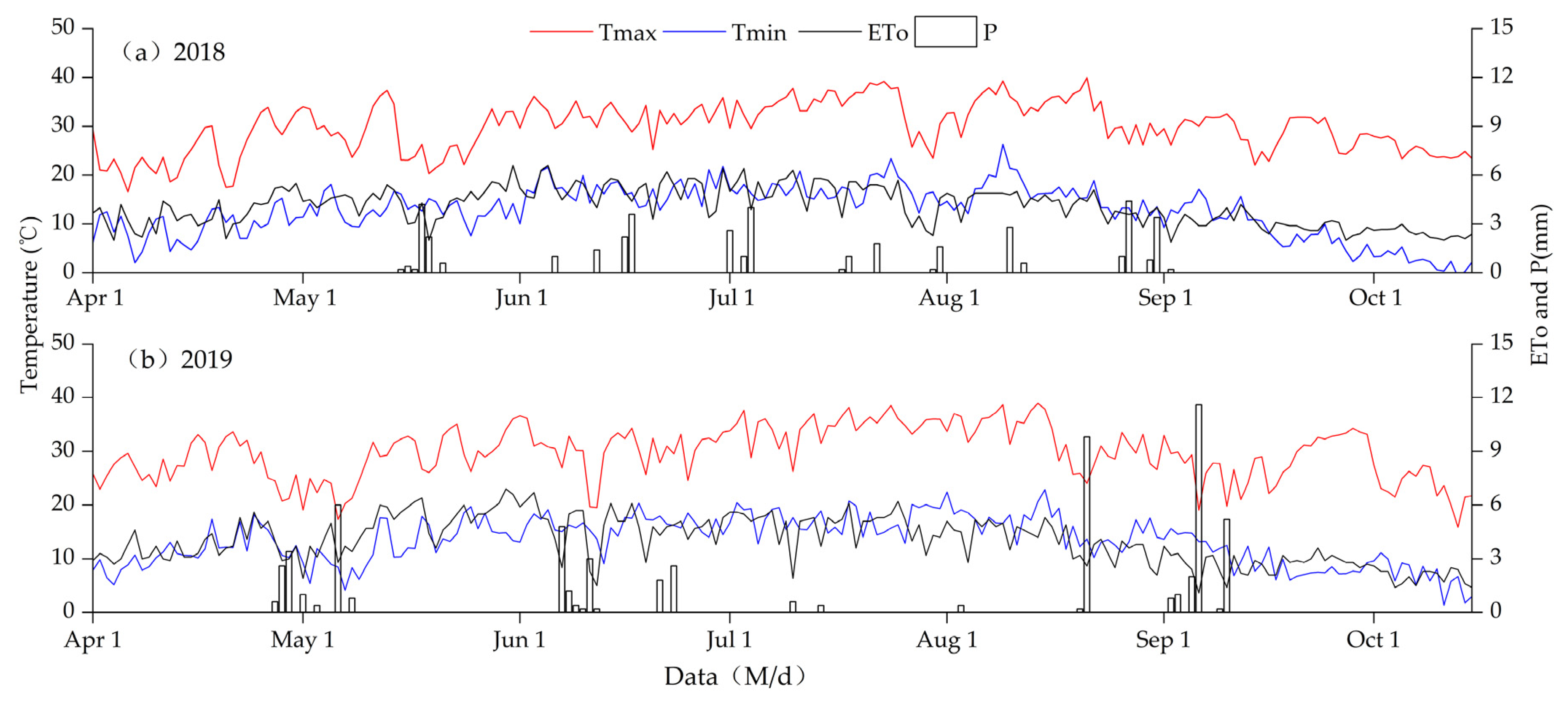
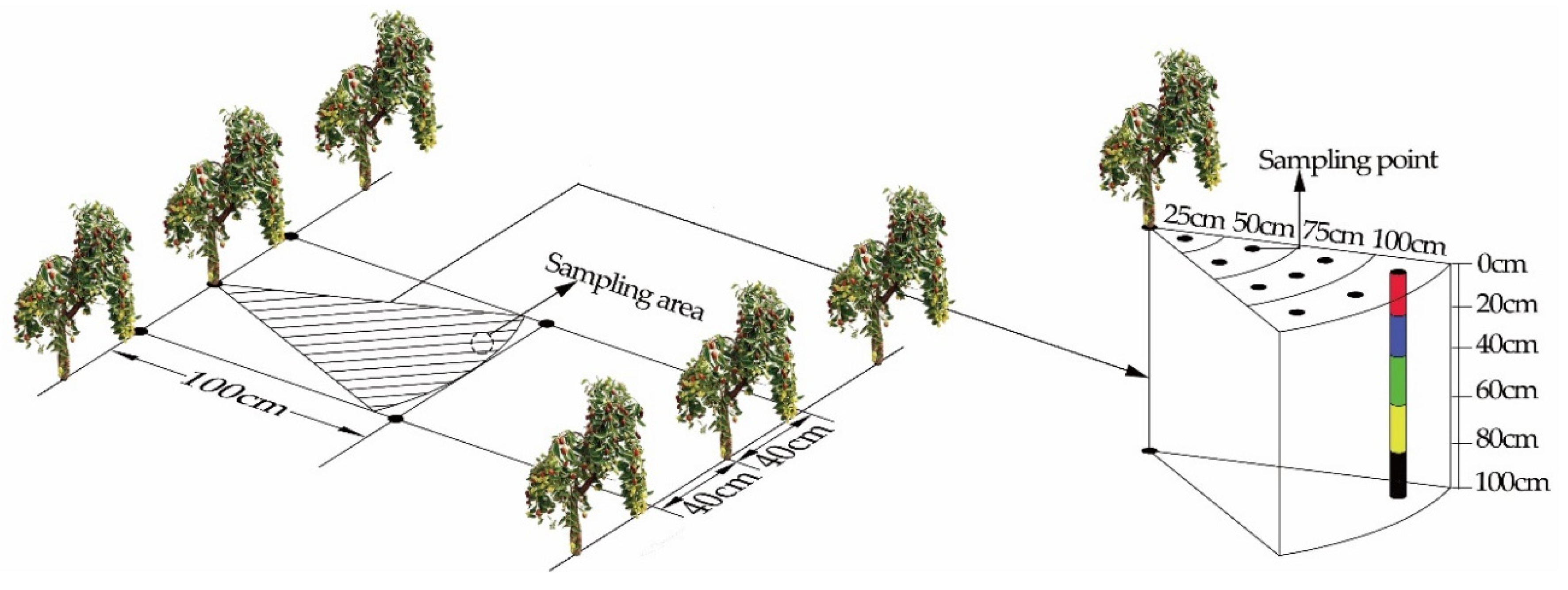



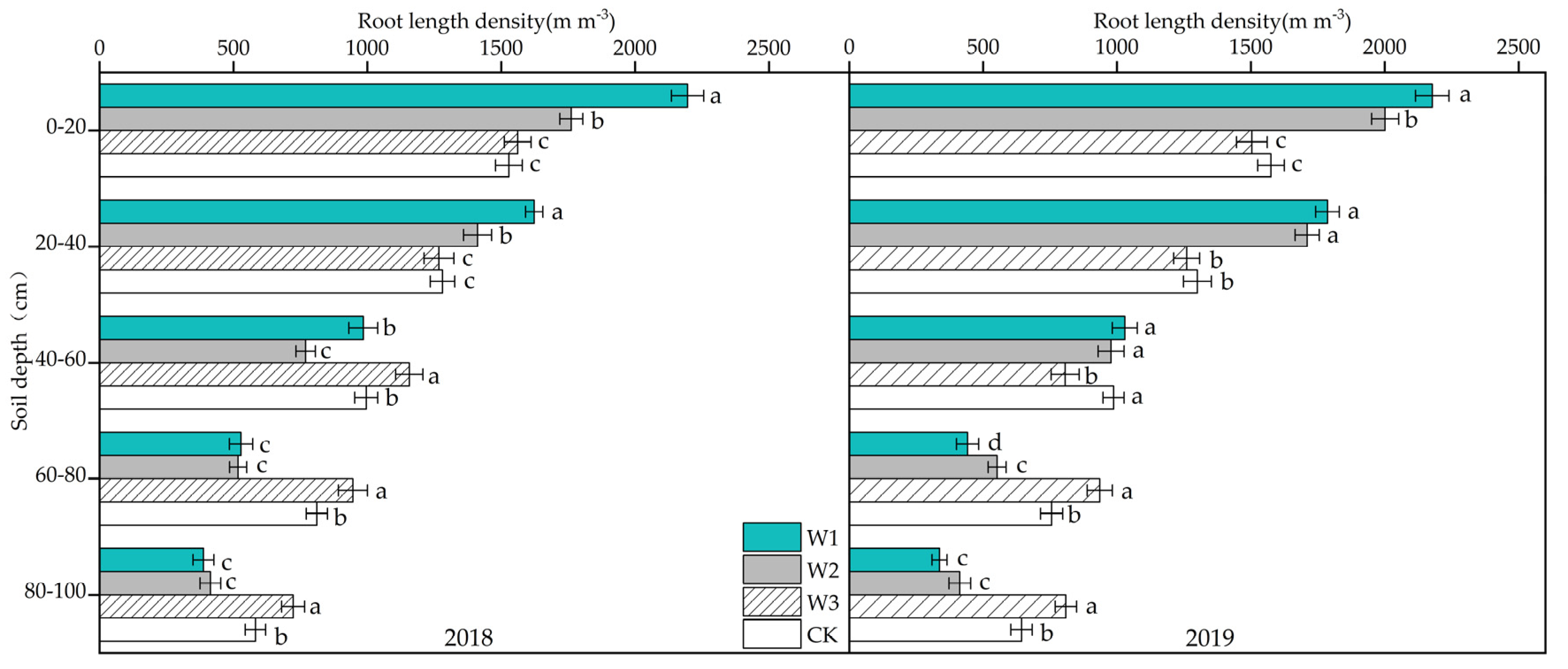

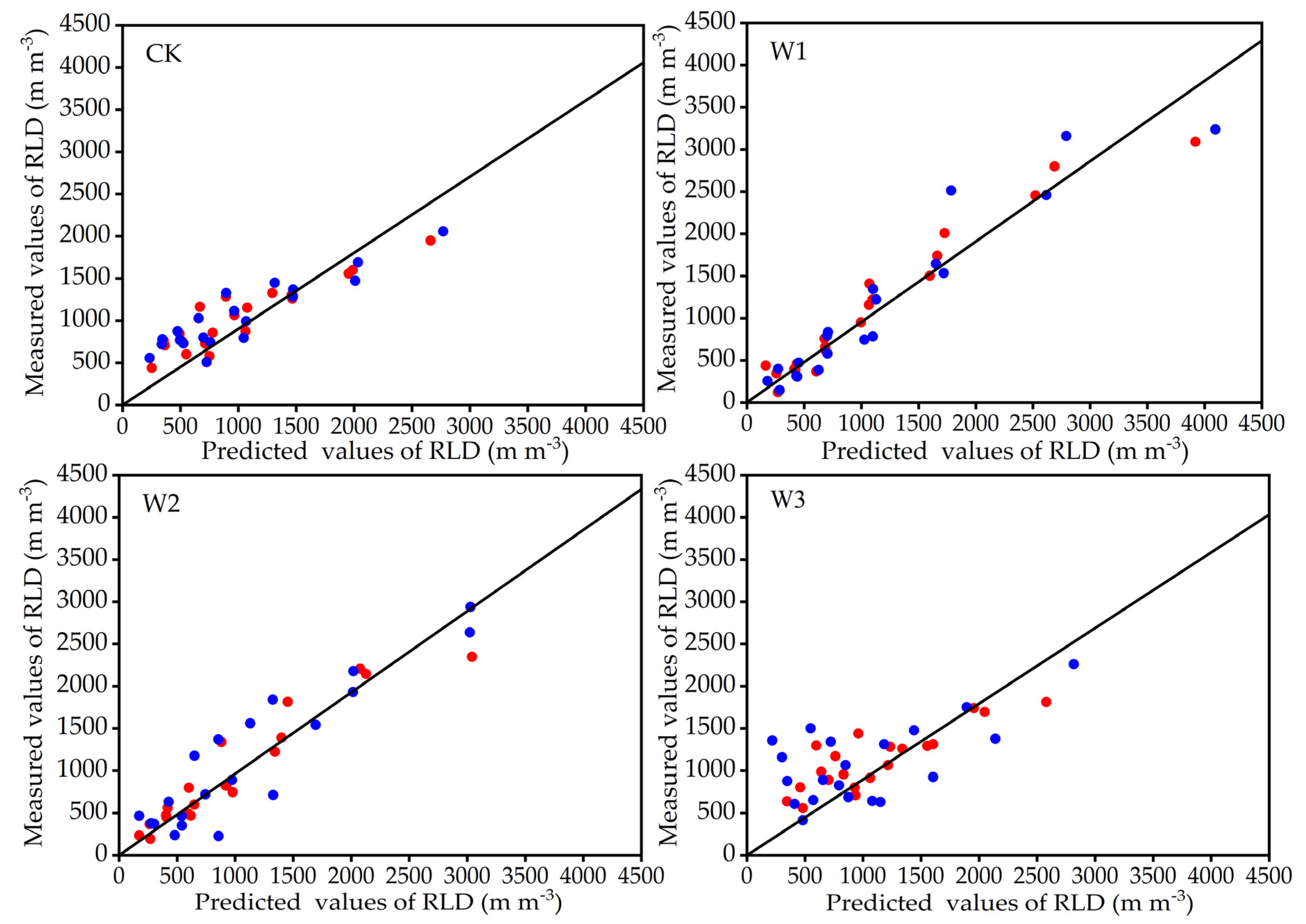
| Soil Depth (cm) | Soil Texture | θFC (cm3 cm−3) | Soil Bulk Density (g cm−3) | Total Nitrogen (g kg−1) | Available Phosphorus (mg kg−1) | Available Potassium (mg kg−1) |
|---|---|---|---|---|---|---|
| 0–20 | Sandy loam soil | 0.316 | 1.52 | 1.23 | 50.24 | 121.58 |
| 20–40 | Sandy loam soil | 0.342 | 1.53 | 1.27 | 48.37 | 109.38 |
| 40–60 | Sandy loam soil | 0.349 | 1.54 | 1.26 | 42.41 | 96.57 |
| 60–80 | Sandy soil | 0.322 | 1.57 | 0.94 | 36.32 | 87.72 |
| 80–100 | Sandy soil | 0.319 | 1.57 | 0.67 | 28.71 | 63.21 |
| Year | Growth Stage | Period | Irrigation Treatment (mm) | Irrigation Events Drip/Flood | |||
|---|---|---|---|---|---|---|---|
| W1 | W2 | W3 | CK | ||||
| 2018 | Germination and New shoot | 4/30–6/15 | 146.7 | 110 | 73.3 | 183.3 | 2/1 |
| Flowering and Fruit setting | 6/16–7/20 | 366.6 | 275 | 183.3 | 366.7 | 5/2 | |
| Fruit swelling | 7/21–8/31 | 293.4 | 220 | 146.7 | 366.7 | 4/2 | |
| Fruit ripening | 9/1–10/20 | 73.3 | 55 | 36.7 | 183.3 | 1/1 | |
| 2019 | Germination and New shoot | 5/3–6/20 | 146.7 | 110 | 73.3 | 183.3 | 2/1 |
| Flowering and Fruit setting | 6/21–7/23 | 366.6 | 275 | 183.3 | 366.7 | 5/2 | |
| Fruit swelling | 7/24–9/3 | 293.4 | 220 | 146.7 | 366.7 | 4/2 | |
| Fruit ripening | 9/4–10/25 | 73.3 | 55 | 36.7 | 183.3 | 1/1 | |
| Year | Soil Depth (cm) | d < 2 mm | d > 2 mm | ||||||
|---|---|---|---|---|---|---|---|---|---|
| W1 | W2 | W3 | CK | W1 | W2 | W3 | CK | ||
| 2018 | 0–20 | 2101.6 aA | 1710.7 aB | 1480.9 aC | 1451.4 aC | 94.9 aA | 51.4 aC | 80.8 bB | 77.7 bB |
| 20–40 | 1581.1 bA | 1367.3 bB | 1150.5 bC | 1162.8 bC | 42.4 bB | 44.7 abB | 117.1 aA | 118.1 aA | |
| 40–60 | 946.1 cB | 731.1 cC | 1111.4 bA | 929.7 cB | 38.8 bBC | 38.5 bcBC | 45.4 cB | 66.2 bcA | |
| 60–80 | 519.8 dC | 500.2 dC | 864.2 cA | 760.3 dB | 8.4 cD | 16.9 dC | 81.9 bA | 51.2 cB | |
| 80–100 | 377.8 eC | 404.8 eC | 711.9 dA | 568.3 eB | 9.8 cA | 8.9 eA | 10.9 dA | 13.7 dA | |
| 2019 | 0–20 | 2070.2 aA | 1955.2 aB | 1412.2 aC | 1499.1 aC | 107.1 aA | 46.4 aD | 91.7 bB | 76.3 bC |
| 20–40 | 1737.7 bA | 1662.9 bA | 1149.9 bB | 1181.7 bB | 48.8 bB | 47.7 aB | 110.5 aA | 118.9 aA | |
| 40–60 | 995.2 cA | 931.1 cA | 753.2 deB | 918.1 cA | 34.3 cC | 46.8 aBC | 53.4 cB | 69.3 bA | |
| 60–80 | 425.5 dD | 521.1 dC | 842.3 cA | 707.4 dB | 16.6 dD | 31.4 bC | 93.5 bA | 48.5 cB | |
| 80–100 | 325.4 eC | 391.3 eC | 780.0 cdA | 631.8 edB | 11.6 dB | 21.5 cA | 29.2 dA | 11.9 dB | |
| Year | Irrigation Treatment | Pz | Pr | RMSE | R2 |
|---|---|---|---|---|---|
| 2018 | W1 | 3.29 | 1.40 | 0.34 | 0.94 |
| W2 | 2.69 | 1.27 | 0.44 | 0.90 | |
| W3 | 1.19 | 0.74 | 0.84 | 0.70 | |
| CK | 1.80 | 0.96 | 0.70 | 0.84 | |
| 2019 | W1 | 3.38 | 1.45 | 0.42 | 0.90 |
| W2 | 2.93 | 2.03 | 0.51 | 0.84 | |
| W3 | 1.37 | 1.53 | 0.86 | 0.61 | |
| CK | 1.98 | 1.04 | 0.71 | 0.83 |
| Year | Treatment | Y (kg ha−1) | ET (mm) | WUE (kg m−3) |
|---|---|---|---|---|
| 2018 | W1 | 8735 ± 259 a | 890.3 ± 48.2 b | 98.1 ± 3.1 c |
| W2 | 8297 ± 218 b | 687.9 ± 38.6 c | 120.6 ± 4.2 b | |
| W3 | 6528 ± 176 c | 480.2 ± 35.7 d | 135.9 ± 4.6 a | |
| CK | 8043 ± 279 b | 1037.7 ± 53.3 a | 77.5 ± 1.9 d | |
| 2019 | W1 | 8896 ± 247 a | 898.3 ± 38.6 b | 99.0 ± 3.8 b |
| W2 | 8712 ± 276 a | 694.2 ± 31.2 c | 125.5 ± 3.6 a | |
| W3 | 6022 ± 165 c | 489.3 ± 28.3 d | 123.1 ± 2.9 a | |
| CK | 8094 ± 242 b | 1041.3 ± 47.6 a | 77.7 ± 3.2 c |
Publisher’s Note: MDPI stays neutral with regard to jurisdictional claims in published maps and institutional affiliations. |
© 2021 by the authors. Licensee MDPI, Basel, Switzerland. This article is an open access article distributed under the terms and conditions of the Creative Commons Attribution (CC BY) license (https://creativecommons.org/licenses/by/4.0/).
Share and Cite
Li, Z.; Zong, R.; Wang, T.; Wang, Z.; Zhang, J. Adapting Root Distribution and Improving Water Use Efficiency via Drip Irrigation in a Jujube (Zizyphus jujube Mill.) Orchard after Long-Term Flood Irrigation. Agriculture 2021, 11, 1184. https://doi.org/10.3390/agriculture11121184
Li Z, Zong R, Wang T, Wang Z, Zhang J. Adapting Root Distribution and Improving Water Use Efficiency via Drip Irrigation in a Jujube (Zizyphus jujube Mill.) Orchard after Long-Term Flood Irrigation. Agriculture. 2021; 11(12):1184. https://doi.org/10.3390/agriculture11121184
Chicago/Turabian StyleLi, Zhaoyang, Rui Zong, Tianyu Wang, Zhenhua Wang, and Jinzhu Zhang. 2021. "Adapting Root Distribution and Improving Water Use Efficiency via Drip Irrigation in a Jujube (Zizyphus jujube Mill.) Orchard after Long-Term Flood Irrigation" Agriculture 11, no. 12: 1184. https://doi.org/10.3390/agriculture11121184




